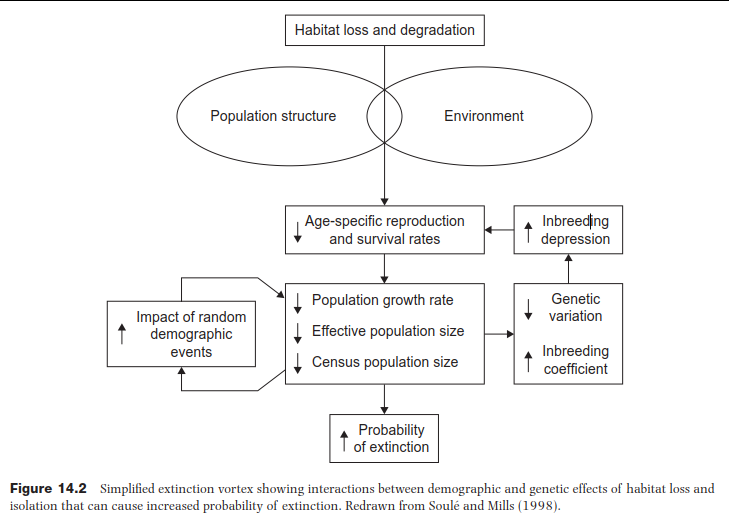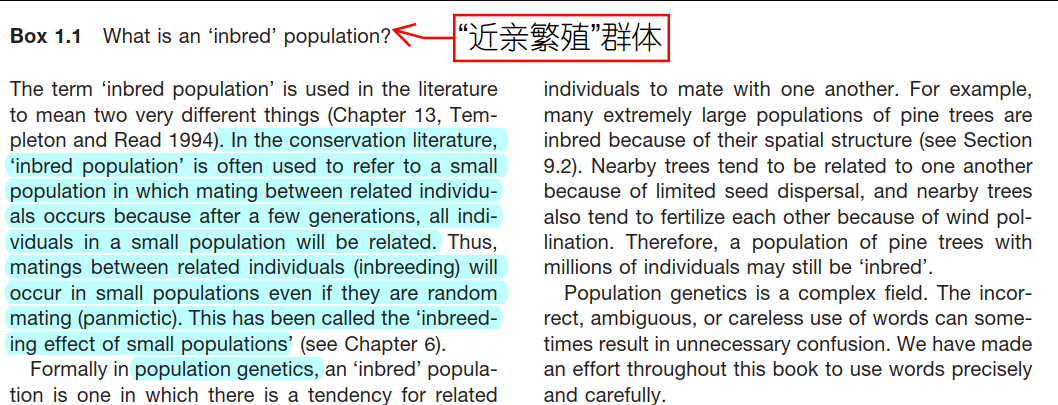---------------------------------第一章-----------------------------------
0、demographic:statistical description of populations
1、Extinction is a demographic process: the failure of one generation to replace itself with a subsequent generation.
2、Those species that will be valued most highly under the schemes that weigh phylogenetic distinctness are those that may be considered evolutionary failures. Evolution occurs by changes within a single evolutionary lineage (anagenesis) and the branching of a single evolutionary lineage into multiple lineages (cladogenesis).
3、The amount of genetic variation within a population may also play an important ecosystem role in the relationships among species in some functional groups and ecosystems.
4、Extinction is a demographic process: the failure of one generation to replace itself with a subsequent generation. Demography is of primary importance in managing populations for conservation。
5、Populations are subject to uncontrollable are subject to uncontrollable stochastic demographic factors as they become smaller. It is possible to estimate the expected mean and variance of a population’s time to extinction if one has an understanding of a population’s demography and environment。
6、There are two main types of threats causing extinction: deterministic and stochastic threats。 Deterministic threats are habitat destruction, pollution, overexploitation, species translocation, and global climate change. Stochastic threats are random changes in genetic, demographic or environmental factors。
7、Genetic stochasticity is random genetic change (drift) and increased inbreeding (Shaffer 1981). Genetic stochasticity leads to loss of genetic variation (including beneficial alleles) and increase in frequency of harmful alleles. An example of demographic stochasticity is random variation in sex ratios, for example producing only male offspring.
8、 extinction vortex(灭绝回旋):Under some conditions, extinction is likely to be influenced by genetic factors. Small populations are also subject to genetic stochasticity, which can lead to loss of genetic variation through genetic drift. The ‘inbreeding effect of small populations’ (see Box 1.1) is likely to lead to a reduction in the fecundity and viability of individuals in small populations. For example, Frankel and Soulé (1981, p. 68) suggested that a 10% decrease in genetic variation due to the inbreeding effect of small populations is likely to cause a 10–25% reduction in reproductive performance of a population. This in turn is likely to cause a further reduction in population size, and thereby reduce a population’s ability to persist。


9、Estimation of the number of unique genotypes can be used to estimate total population size in populations that are difficult to census。Many demographic models assume a single random mating population. Examination of the distribution of genetic variation over the distribution of a species can identify what geographic units can be considered separate demographic units.
---------------------------------第二章:自然种群的表型变异-----------------------------------
1、Adaptive evolutionary change within populations consists of gradual changes in morphology, life history, physiology, and behavior.Such traits are usually affected by a combination of many genes and the environment, so that it is difficult to identify single genes that contribute to the genetic differences between individuals for many of the phenotypic traits that are of interest.
2、Variation is the essence of genetics
3、Morphological variation is everywhere. However, there are serious difficulties with using morphological traits to understand patterns of genetic variation. The biggest
problem is that variation in morphological traits is caused by both genetic and environmental differences among individuals. Therefore, variability in morphological traits cannot be used to estimate the amount of genetic variation within populations or the amount of genetic divergence between populations.
4、The heritability of a trait is defined as the proportion of the total phenotypic variation that has a genetic basis (VG /VP). The greater the heritability of a trait, the more
phenotypic differences among individuals within a population are due to genetic differences among individuals
5、Genetically based differences in behavior are of special interest in conservation because many behavioral differences are of importance for local adaptation and because captive breeding programs often result in changes in behavior because of adaptation to captivity




 浙公网安备 33010602011771号
浙公网安备 33010602011771号